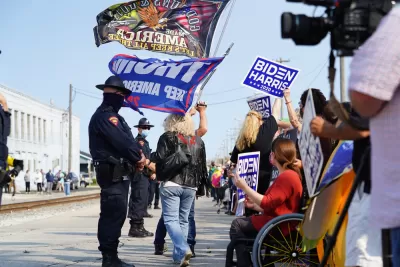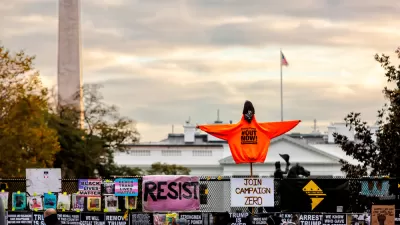Trump has been repeatedly criticized for misunderstanding the suburbs, but former Vice President Jose Biden's take on the subject during the debate also missed the mark.

Anyone who tuned into the presidential debate earlier this week in the hopes that a promised segment on race and violence in cities would reveal a substantive and revealing discussion was probably disappointed.
Kriston Capps and Laura Bliss provide commentary and analysis of one of the few coherent moments from the debates—when the conversation briefly turned to the subject of the suburbs.
Here's the debate exchange, as transcribed in the article:
“Our suburbs would be gone” under a Biden presidency, [Trump] said. “You would see problems like you’ve never seen before.”
Biden replied: “He wouldn’t know a suburb unless he took a wrong turn. I was raised in the suburbs. This is not 1950. All these dog whistles and racism don’t work anymore. Suburbs are by and large integrated.”
The point made by Trump is familiar, having been a key talking point for several months now, and Biden's response is probably an echo of the many criticisms of Trump's understanding of the suburbs. So, Bliss and Capps instead take issue with Biden's use of the word "integrated," which they characterize as "not quite right."
Here's how the writers summarize the criticism:
“The suburbs” is a sweeping American category that includes the the majority of the U.S. population. As of 2010, they also contain the majority of every demographic group. In that sense the suburbs are indeed diverse. But as Brookings Nonresident Senior Fellow Elizabeth Kneebone has written, “they don’t live in the same suburbs.” Within the vast swath of American land that is vaguely defined as the suburbs, racial and ethnic groups remain separated.
The problem is segregation, according to Capps and Bliss, which is why the federal Fair Housing Act is necessary, and why the Trump administration has worked throughout the last four years to weaken enforcement of fair housing rules.
"So are suburbs 'by and large integrated'?" ask Capps and Bliss to interrogate the statement by Biden during the debate.
Compared to cities, perhaps, where the concentration of poverty is severe and soaring housing prices have locked out the middle class. But even as the suburbs grow more diverse, they stand to grow more segregated. The Trump administration has done away with the federal government’s best tools for assessing and comparing segregation patterns, which means that growing suburbs may use federal dollars for housing, highways and education in a way that makes segregation worse.
FULL STORY: Diverse? Yes. But Are U.S. Suburbs Actually Integrated?

Alabama: Trump Terminates Settlements for Black Communities Harmed By Raw Sewage
Trump deemed the landmark civil rights agreement “illegal DEI and environmental justice policy.”

Study: Maui’s Plan to Convert Vacation Rentals to Long-Term Housing Could Cause Nearly $1 Billion Economic Loss
The plan would reduce visitor accommodation by 25% resulting in 1,900 jobs lost.

Planetizen Federal Action Tracker
A weekly monitor of how Trump’s orders and actions are impacting planners and planning in America.

Wind Energy on the Rise Despite Federal Policy Reversal
The Trump administration is revoking federal support for renewable energy, but demand for new projects continues unabated.

Passengers Flock to Caltrain After Electrification
The new electric trains are running faster and more reliably, leading to strong ridership growth on the Bay Area rail system.

Texas Churches Rally Behind ‘Yes in God’s Back Yard’ Legislation
Religious leaders want the state to reduce zoning regulations to streamline leasing church-owned land to housing developers.
Urban Design for Planners 1: Software Tools
This six-course series explores essential urban design concepts using open source software and equips planners with the tools they need to participate fully in the urban design process.
Planning for Universal Design
Learn the tools for implementing Universal Design in planning regulations.
Caltrans
Smith Gee Studio
Institute for Housing and Urban Development Studies (IHS)
City of Grandview
Harvard GSD Executive Education
Toledo-Lucas County Plan Commissions
Salt Lake City
NYU Wagner Graduate School of Public Service




























